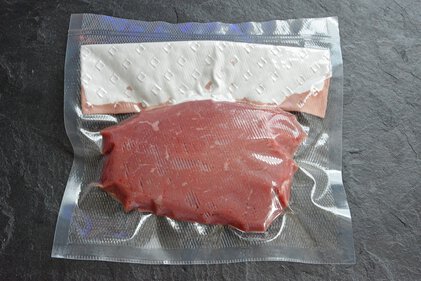The physics of sous vide cooking
The term “Sous Vide” (French for “under vacuum”) is actually only a partial description of the cooking process. After all, in addition to the vacuum bag, another main feature is also a special cooking unit, the Sous Vide cooker, which is similar to bain-marie.
Only this type of device is able to offer the numerous fundamental advantages of the Sous Vide procedure in a practical manner. Sous Vide cookers use water as the heat transfer medium and must be able to maintain the set water temperature very precisely and, just as importantly, at every point of the water bath.
The cooking procedure
„Thermography video of a 19 l water bath without circulation“
The food is warmed by electrical heating that does not come into direct contact with the food being cooked. In contrast to cooking, roasting or grilling, the actual heat transfer medium, in this case water, is heated to the required temperature and then kept constant. The food is hermetically sealed in the film bag and neither comes into contact with water during cooking nor with air. This creates the unique advantages of the Sous Vide procedure that have been described in the section explaining Sous Vide basics.
Water serves as the perfect heat transfer medium because it completely covers the temperature range required for cooking and its temperature can be precisely regulated. It is also readily available everywhere and economical for the required quantities.
Often overlooked, however, is that water has a very high specific heating capacity. This is generally very convenient for maintaining a constant temperature, but when it comes to heat conductivity things look less favorable. A little comparison: Iron transports heat better by a factor of 134 and copper has heat conductivity that is 670 times better than water.
„Thermography Video Diamond S with Circulation“
It is clear from this that continuous, powerful and uniform circulation of the water heat transfer material is needed to achieve the desired cooking result. More information about this important aspect can be found in the section “Why fusionchef?”
If there are inadequacies when it comes to the temperature accuracy, temperature stability or uniform heat distribution in the bath tank, then the specific advantages of the Sous Vide procedure cannot be completely achieved as these factors are decisively important when it comes to low temperature cooking.
„Thermography Video Sous Vide stick with Circulation“
Flavor-safe vacuum bags

The only “interface” between the heat transfer material and the food is the vacuum bag. On the one hand it has the task of stopping air from reaching the food, and on the other hand it also naturally needs to be watertight so that valuable flavors can’t escape and water can’t get in from outside.
The film also needs to transfer the heat from the surrounding water medium to the food being cooked.
To ensure good warming, it’s important that no or as little air as possible is in the bag, as this would greatly increase the thermal resistance. All food should therefore be vacuum packed in such a way that the film is in direct contact with the food as much as possible. The best way to achieve this is explained in the section “Correct vacuuming.”

